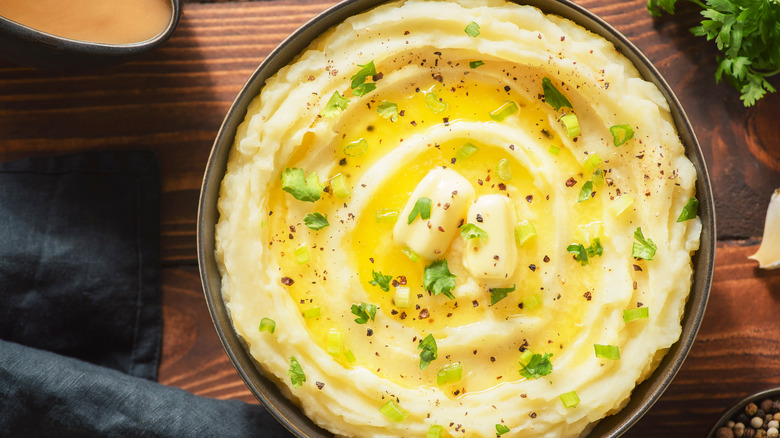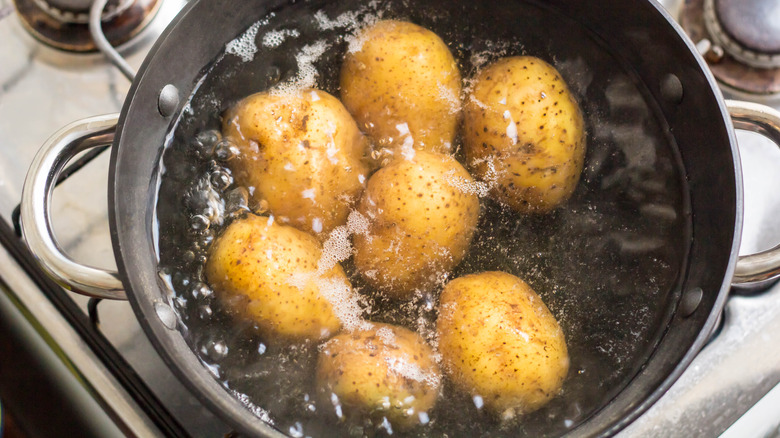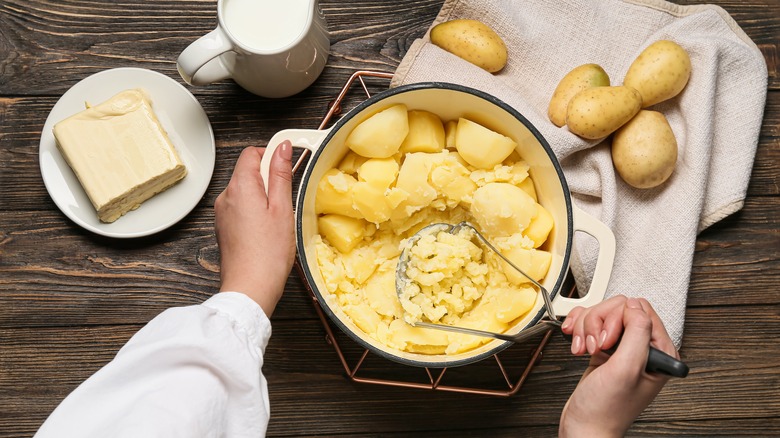Why You Shouldn't Make Mashed Potatoes On High Heat
Potatoes are a simple wonder, with many different ways to prepare them found in kitchens and cuisines across the world. From classic, simple sides like the baked potato, to rich mains like gnocchi, to any variety of fried breakfast offerings (hash browns, tater tots, and home fries anyone?), potatoes have a way to grace tables for any and every occasion.
One of the most common ways you'll see this wonder veg served across North America is in hearty mashed potatoes. Many agree the earliest recipe for mashed potatoes dates back to the mid-1700s, in an English cookbook called "The Art of Cookery," by Hannah Glasse (via Tedium). Since then, it seems everyone's tried their hand at mashing potatoes, including the unlikely but dynamic duo Martha Stewart and Snoop Dogg in 2008.
Despite mashed potatoes being a staple in many home kitchens, there are a few common mistakes many home cooks will make. But as with any simple, standard recipe, there are a few tricks you can use to take your mash from crowd pleaser to show stopper. It could all come down to the heat.
Keep the heat low for the perfect consistency
When boiling your potatoes, keep the heat no higher than medium. Chefs like Chicago-based Kevin McAllister recommend going low and slow for this portion of the process (via CookingLight). Potatoes contain a lot of moisture, and heat drives moisture out of the potato faster, according to FoodCrumbles. Keeping the heat low will help you control how much moisture stays in the potatoes for better consistency.
When the potatoes are ready for mashing, it's still important to pay attention to temperature. Not only do potatoes mash easiest when they're still freshly hot from cooking, but higher heat when boiling means the potatoes can absorb more water and become waterlogged. You'll want your potatoes dry for mashing, so they have room to absorb the flavor of your chosen dairy products, per SeriousEats. Returning your cooked potatoes to low heat can help dry them out to get ready for mashing.
You don't want them too dry, though, as leaving your potatoes on high heat could tarnish the lovely fluffy texture you've created so far. Keep the potatoes off direct heat to avoid scorching, and instead place them on the top of a double boiler over some gently simmering water to keep that perfect moisture level intact (via Fine Cooking).
Following these steps, you should be on your way to serving up a perfectly warm, creamy, and fluffy version of this classic dish.
Set up for success by starting your mashed potatoes cold
Just as any good helping of mash starts by boiling your potatoes, our tips start at the boiling stage (and if you peel your potatoes before boiling, our tips start even earlier!). While the uninitiated might think bringing the water to boil first might save cooking time, starting your potatoes in cold water and bringing them to a gentle boil is an important first step in many recipes, including the one Martha and Snoop were following (via Martha Stewart).
According to Bon Appetit, throwing potatoes straight into boiling water leads to uneven doneness. Potatoes are dense after all. Starting the potatoes in cold water helps them cook more evenly and avoids mushy potatoes. McAllister told CookingLight that "A lot of people boil potatoes at full boil. Yes, it will cook them faster, but this is where you get the outside overcooked and the center of the potato still raw." Cooking the potato evenly throughout will help stop lumps and give you a consistency that's perfect for mashing.
If you have over-boiled your potatoes, there are still a few ways to fix your mash before serving. If your potatoes are runny, you can add some starch back into the potatoes to bulk them up. Potato starch works well, or alternatively you can also add some instant mashed potatoes from a box to thicken your puree (via SeriousEats). Conversely, if your potatoes are too dry or lumpy, keep the heat low and gently mix in more dairy to even out the consistency, explains The Kitchn.


